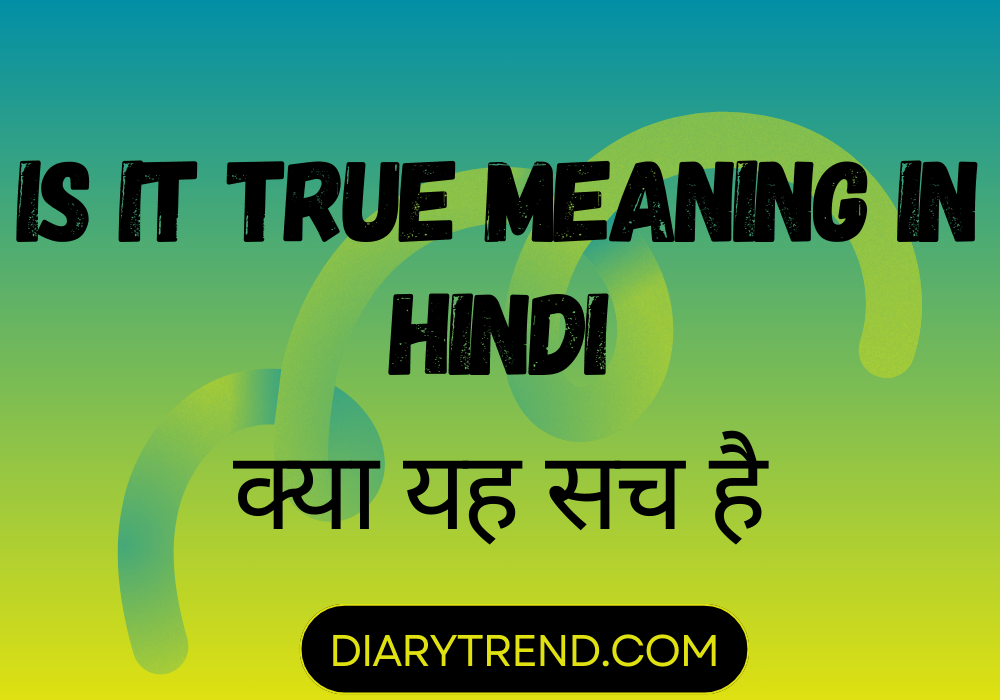“क्या यह सच है” is the Hindi translation of the English phrase “Is it true”. This phrase, simple in its structure, carries significant implications and can be explored in various contexts. Let’s delve into a detailed analysis of this phrase, its linguistic components, cultural relevance, and applications.
1. Linguistic Analysis
a. Translation and Language Structure
In Hindi, “क्या यह सच है” directly translates to “Is it true”. Here, “क्या” means “is”, “यह” translates to “it”, and “सच” means “true”. The phrase is a direct question that seeks confirmation or denial of a statement or belief. The structure of questions in Hindi often follows a subject-object-verb format, slightly differing from the English subject-verb-object order.
b. Semantic Nuances
The phrase carries a sense of inquiry and often skepticism. It’s not just asking for confirmation, but sometimes, implicitly questioning the validity of a statement. This semantic depth adds to the richness of its use in both casual and serious dialogues.
2. Cultural Context
a. Usage in Indian Society
In Indian culture, where Hindi is widely spoken, this phrase is commonly used in daily conversations. It reflects a culture that values truth and clarity. The phrase can be found in various forms of media, literature, and everyday discourse, illustrating its pervasive nature in the fabric of Indian communication.
b. Philosophical and Ethical Dimensions
Indian philosophy, deeply intertwined with the pursuit of truth (‘Satya’), gives this phrase a profound significance. It’s not just a linguistic tool but a reflection of the cultural emphasis on truth and honesty. In ethical discussions, “क्या यह सच है” is a starting point for debates on morality and truth.
3. Applications in Different Fields
a. Journalism and Media
In journalism, the phrase is a fundamental tool for fact-checking and verifying information. The ethos of journalism in India, much like in other parts of the world, relies heavily on the pursuit of truth, making this phrase crucial in journalistic discourse.
b. Legal and Forensic Contexts
In legal settings, the pursuit of truth is paramount. “क्या यह सच है” is akin to asking “Is this the truth?” in a courtroom or an investigation. It reflects the pursuit of factual accuracy and objective truth in the justice system.
c. Education and Academia
In educational settings, this phrase encourages a spirit of inquiry and critical thinking. Teachers and educators often use it to provoke thought and analysis among students, fostering an environment where questioning and verifying facts are encouraged.
4. Comparative Linguistic Perspectives
a. Similar Phrases in Other Languages
Many languages have equivalents of “Is it true”. For example, in Spanish, it’s “¿Es verdad?”, in French, “Est-ce vrai?”, and in Mandarin, “这是真的吗?” (Zhè shì zhēn de ma?). Each of these carries similar connotations but is rooted in their unique linguistic and cultural backgrounds.
b. Translation Challenges
Translating “क्या यह सच है” into other languages, or vice versa, might not always convey the exact sentiment due to cultural nuances. Translation requires understanding the context and the underlying cultural connotations.
5. Conclusion
“क्या यह सच है” is more than a simple translation of “Is it true”; it’s a linguistic representation of the quest for truth and clarity. Its usage spans various fields, reflecting cultural, philosophical, and ethical dimensions. This phrase embodies the universal human endeavor to seek and validate truth, making it a significant element in both language and society.
